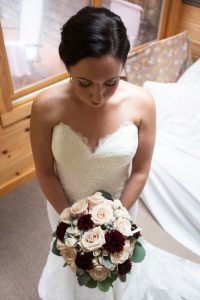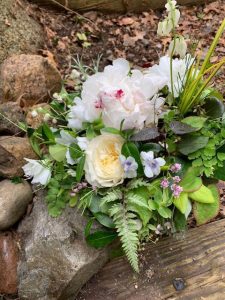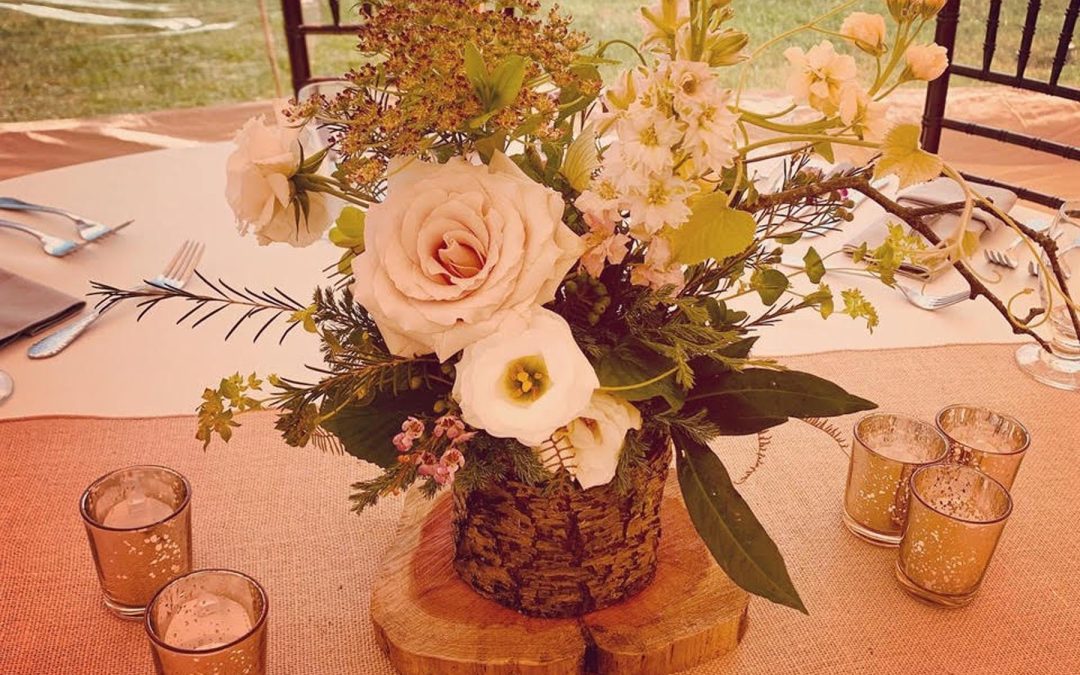By CHRISTINE LYNCH
A slender bride clutches fragrant herbs as she solemnly approaches the man she would wed. For this ancient Roman bride, those herbs symbolized fidelity and fertility and shielded her from evil spirits.
Throughout time, brides have carried flora during their weddings. Flowers, greens, and herbs served a purpose beyond being something pretty to occupy the hands and to add a nice fragrance. In ancient Greece, ivy was carried to assure never-ending love. During Tudor times, English brides held marigolds soaked in rosewater. These being a supposed aphrodisiac, the bride then ate them afterwards.
 From earliest times, flowers offered good fortune and meanings. Back in Victorian times, people used certain fauna to create secret communiques, albeit with rather loose interpretations. For instance, they popularized using roses at weddings, which for them represented true love. It was Queen Victoria who first chose to replace herbs with flowers, which started a trend that continues to today
From earliest times, flowers offered good fortune and meanings. Back in Victorian times, people used certain fauna to create secret communiques, albeit with rather loose interpretations. For instance, they popularized using roses at weddings, which for them represented true love. It was Queen Victoria who first chose to replace herbs with flowers, which started a trend that continues to today
Astrid Brodahl has worked with florals for 21-plus years. She was the floral manager at Windfall Market for 20 years, and now, she’s opened her own Astri Floral Studio. She mentioned that brides enjoy learning these meanings and incorporating a few into their selections. Some examples: White Violets imply, “Let’s take a chance.” If you want True Love, then carry Forget Me Nots; Alsotroemeria offers devotion, wealth, prosperity, and fortune; Bird of Paradise is a symbol of faithfulness, but then again so is the dandelion. Caladiums proffer great joy and delight; Gypsophila for fertility; Heather for good luck; Yellow Iris for passion.
Greenery also provided good luck. As with ivy symbolizing never-ending love and fidelity, eucalyptus signifies abundance, protection, and good health. Herbs such as garlic, chives, and rosemary help ward off evil, with an extra measure of good luck. Fragrance offers another important meaning, too. “I’ll let a bride inhale a rose or peony, and the fragrance often evokes an early memory for her, Mr Brodahl said.”
Born and raised in Norway, Ms. Brodahl learned to love flowers at an early age. Scandinavian simplicity, influenced by nature, infuses her designs. “It’s in my nature, my very bones, she said.” She works exclusively with area sources; “I’m very passionate about using local fauna and local growers.” From her many years’ experience, she said, “most brides are looking for that.”
Bouquet design is endlessly varied. The shape can be cascading or round and compact; the color palette might be monochrome or blended; the flowers and greenery might be unembellished or enhanced by beads and ribbons. Ms. Brodahl sometimes suggests a European style bouquet, which is flatter. “It looks as though you’re holding a little garden.” She also enjoys creating botanical wear, “using floral touches for bowties and hair pieces.” She said she wants to make brides happy through her work. “I pay attention to what they’re saying and to understand what they’re dreaming, she said.”
Floral designers know which type flowers and stems hold up better, and which are easier (and less expensive) to obtain in certain seasons. Depending on what type of wedding a couple wants, the florals can be basic or more elaborate. On average, advice suggests allowing about ten percent of the overall wedding budget for flowers. Still, the florists in this article all said they always work within the bride’s cost plan. JoAnn Sparks, owner of The Salty Florist, emphasized that every bride should have the beautiful wedding she wants: “I don’t turn anyone away; I work with their budget.”
For traditional weddings, the mothers of the bride and groom each get a corsage, and the groom, dads, and the groomsmen sport boutonnieres. By the way, throughout history a groom’s boutonniere was worn for protection against evil. For latter-day weddings, it’s now placed on the groom’s left lapel to guard his heart. In Sweden and Denmark grooms have been known to sew small pockets of strong-smelling herbs like garlic, chives, and rosemary into their clothes for good luck.

A bouquet by Astrid Brodahl
There might be a flower girl(s) who usually wears a floral headpiece and tosses either flowers or petals where the bride will walk. If the ceremony is in a special venue or church, the entryway can be draped with garlands, an arrangement placed by the sign-in book, and nosegays affixed to each aisle seat. The bridesmaids and bride hold wedding bouquets and there might be an optional smaller tossing bouquet for when the bride departs the wedding reception.
The custom of tossing the bouquet originated in the Middle Ages when brides were accosted by drunken wedding revelers as she tried to leave. They wanted a piece of her clothing for good luck, with a garter being a big prize. For self-preservation she would toss anything she carried, which often was her florals. Also, it’s been told, she would remove her garter and let her husband throw it to the crowd so they could make their escape. Later, in Victorian times, the bride would toss her flowers to share her good fortune with the person catching the bouquet. Nowadays, usually only single ladies are invited to try catching it to see who will be the next to marry. Lately, the custom of tossing the garter to the single gentlemen in the room has fallen somewhat out of favor for modern brides.
Flowers in the reception area also make an inviting impression when guests walk in, seeing the tables festooned with centerpieces reflecting the wedding colors. For years, table centerpieces had the number of one of the place settings taped underneath. Then, as guests started to leave, the person in that corresponding seat got to take the arrangement. More fun floral touches include hanging kissing balls about the reception and dance floor as well as adorning the cake with small edible flowers or petals.
Ms. Sparks, who had 12 years of floral experience prior to opening her Main Street Falmouth store in 2020, offers personal bridal consultation and her website www.TheSaltyFlorist.com includes an online chat option. She said that most brides nowadays “have their own ideas about what they want.” Still, she knows that “Sitting down talking with them and giving them good visual examples creates a connection with the flowers, the florist, and the customer.” Currently she’s designing thirty weddings for this year and booking weddings into 2021.
A large rack in her store displays bunches of flowers and greens hanging upside down to dry. Ms. Sparks mentioned that dried flowers and herbs are among this year’s trends in wedding florals. She listed some others, “Definitely, dried flowers, pampas type grasses, and bleached greenery.”
She visits The Flower Market and works with local growers as much as possible. To supplement these sources, she and her husband have planted upwards of three thousand bulbs and abundant seeds on their property so they have a supply of organically grown dahlias, tulips, delphiniums, peonies, ranunculus, and herbs.
For those starting to plan a wedding, have some fun playing with the colors, shapes, and meanings of flowers, greenery, grasses, and herbs. Working with an innovative floral designer will help interweave your ideas for a perfect wedding.
Preserving The Bouquet
For brides wanting to preserve their special bouquet, many online sites offer instructions for this. A common way to preserve flowers is to place them between sheets of wax paper and tuck them into a large book. Then press that book with a stack of others and leave it for several weeks. This will totally flatten the bouquet, but the flowers will keep. You also can commission a painting to show every detail of the fresh arrangement.
Here are some other ideas:
Freeze drying: Shortly after the ceremony, place the flowers stems down into a freezer without them touching anything.
Air drying: Suspend the flowers upside down in a dark, dry spot. Allow at least two weeks for them to be completely dry. However, the color fades with this technique.
Glycerin Dip: Mix two parts warm water with one part glycerin. Stand the flowers in a container and cover with the solution. This might have mixed results because certain flowers fare better than others with this method.
Sand/Silica Gel: Stand the flowers in a container and fill it gently and completely with super fine sand, which can be mixed with silica gel. Cover and leave for two weeks.

